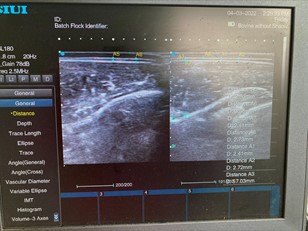Recording the Sussex breed
Performance recording benefits Sussex breeders by Laura Eyles, Signet
Performance records provided by Signet’s Beefbreeder service give breeders and purchasers an objective way of assessing the genetic merit of breeding animals. Through the analysis of pedigree and performance records a range of Estimated Breeding Values (EBVs) and Breeding Indexes are generated.
All the data collected is available on the Signet website, where clients have access to various online breeding reports, inbreeding software, a sale catalogue creator and breeding charts that can be displayed at sales. This report explains how three leading Sussex breeders have benefitted from the service.
An incentive to breeders from the Sussex Cattle Society
The Sussex Cattle Society have introduced an initiative to enable herds to access Signet’s online performance recording services; covering the recording costs to any Society member that has paid their capitation fees and thus removing the financial barrier that may have previously deterred herds from weight recording.
During a recent trip down to Kent to ultrasound scan several Sussex herds, I discussed with breeders the importance of recording, how recording has helped them and their current breeding objectives. A common topic from our on-farm discussions was the great demand for recorded bulls. With breeders continually looking to source new genetics from recorded herds which have good figures and meet breed standards. Clearly EBVs are an important marketing tool when selling stock, but they also help breeders make more informed choices, as can be seen through the genetic progress achieved in these herds.
Goldstone Herd – Chandler & Dunn Ltd
The Goldstone herd was founded in 1922 and has used performance recording for several decades. Roger Dunn reported the herd was using ultrasound scanning alongside weight recording, even before the days of Signet and carcase conformation has improved as a result. This has been observed first-hand as the cattle which are not kept or sold for breeding animals are processed and sold through the farm shop.
Roger believes there is a significant benefit from recording with Signet, where ultrasound scanning combined with regular weighing provides greater knowledge about the animals, providing data for breeders to make informed decisions for not only the retention of stock but also the selection of breeding animals for sale.
Roger suggests that the more breeders that scan the better, new breeders also need to understand that just because their initial breeding values may be low to start with their best cattle are still good animals and it may take a little time for this to become clear from the data provided.
Boxted Herd – L Stevens and Son
The Boxed herd is another long-standing herd of Sussex cattle, with the first animals purchased in 1962. David stated that the use of Signet’s services has allowed the Boxted herd to achieve a greater uniformity using EBVs as a tool to aid selection decisions.
The Stevens family have a strong commercial focus, specifically looking at 200- and 400-day weight EBVs combined with superior EBVs for muscle depth. Over the past 10 years, David has noted an increase in growth rate within the herd because of their selection protocols and making informed decisions based on the data provided. David believes recording should be a continuous process, with ultrasound scanning of equal value to weight recording. He recognises this is an extra expense for small herds, but ultimately worthwhile especially as herds increase in size.
Elbridge Herd – E H Holdstock & Son
The Elbridge herd was established in 1946, with the purchase of 4 heifers and is now one of the largest herds in the country. Verity Holdstock says “recording is important as it gives you something tangible to follow and track. It can really help in the decision-making process of which bulls to register with the Breed Society and which females are the correct ones to keep for replacements.”
The Elbridge herd regularly undertake scanning and have found that this data can be utilised to compare individual animal performance against farm benchmarks that the Holdstock family have implemented for growth and carcase traits without compromising calving ease. These being focal traits for the herd when retaining breeding stock. Performance records are used in combination with a thorough inspection to ensure cattle are suitable for breeding and meet breed standards.
What is ultrasound scanning and how is the data used?
 Ultrasound scanning services provide cattle breeders with the opportunity to assess the carcase quality of their cattle by measuring muscle and fat levels in the live animal. Cattle are scanned between 350 and 500 days of age. A single measure of muscle depth and eight measures of fat depth are taken. These measurements are then submitted to the forthcoming breeding evaluation.
Ultrasound scanning services provide cattle breeders with the opportunity to assess the carcase quality of their cattle by measuring muscle and fat levels in the live animal. Cattle are scanned between 350 and 500 days of age. A single measure of muscle depth and eight measures of fat depth are taken. These measurements are then submitted to the forthcoming breeding evaluation.
The data is then analysed to identify superior breeding lines. Unlike growth rate, it isn’t easy to identify cattle with superior muscling across the loin. Ultrasound images enable breeders to select these animals and avoid those with a high level of carcase fat.
While this measurement simply reflects muscle depth across the loin, research indicates that selective breeding for muscle depth can greatly enhance total muscle yield.





